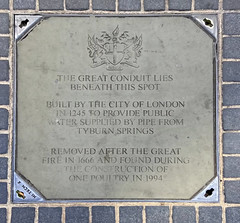The Great Conduit, London
Commemorated on 2 plaques
The Great Conduit stood in this street providing free water 13th century to 1666
Cheapside, London, United Kingdom where it was
The Great Conduit lies beneath this spot. Built by the City of London in 1245 to provide public water water supplied by pipe from Tyburn springs. Removed after the Great Fire in 1666 and found during the construction of One Poultry in 1994
Poultry, London, United Kingdom where it sited


